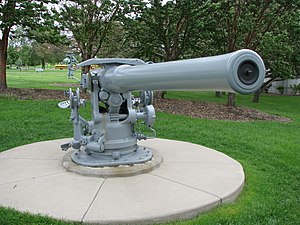| 4″/50 caliber gun Marks 7, 8, 9, and 10 | |
|---|---|
 The gun from USS Ward which fired the first American shot of World War II at Pearl Harbor on 7 December 1941 at the State Capitol grounds in St. Paul, Minnesota. | |
| Type | Naval gun |
| Place of origin | United States |
| Service history | |
| In service | 1898–1945 |
| Used by | |
| Wars | |
| Production history | |
| Designer | Bureau of Ordnance |
| Designed |
|
| Manufacturer | |
| No. built |
|
| Variants | Mark 7, 8, 9 and 10 |
| Specifications | |
| Mass |
|
| Length |
|
| Barrel length | All: 200 in (5,080 mm) bore (50 calibres) |
| Shell |
|
| Calibre | 4 in (102 mm) |
| Elevation | -15° to +20° |
| Traverse | -150° to 150° |
| Rate of fire | 8-9 rounds per minute |
| Muzzle velocity |
|
| Effective firing range | Mark 7: 9,000 yd (8,200 m) at 13° elevation |
| Maximum firing range | Mark 9: 15,920 yd (14,560 m) at 20° elevation[1] |
The 4″/50-caliber gun (spoken "four-inch-fifty-caliber") was the standard low-angle, quick-firing gun for United States, first appearing on the monitor Arkansas and then used on "Flush Deck" destroyers through World War I and the 1920s. It was also the standard deck gun on S-class submarines, and was used to rearm numerous submarines built with 3-inch (76 mm) guns early in World War II. United States naval gun terminology indicates the gun fired a projectile 4 inches (10 centimeters) in diameter, and the barrel was 50 caliber. 4x50 meant that the barrel was 200 inches long, or 16 feet long .[2][3]
- ^ a b c Campbell 1985 p.143
- ^ Fairfield 1921 p.156
- ^ Friedman, Norman (2011). Naval Weapons of World War One. Seaforth Publishing. pp. 188–191. ISBN 978-1-84832-100-7.